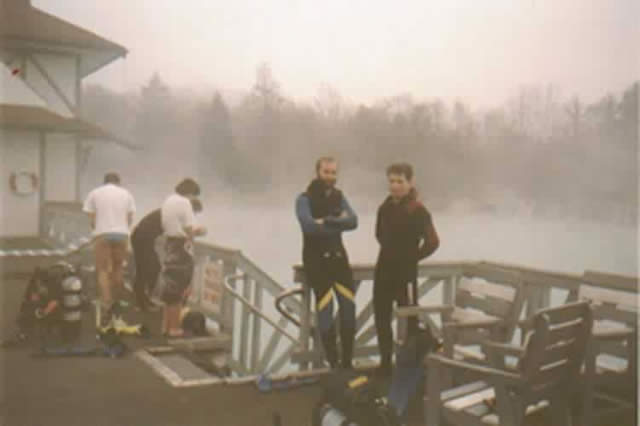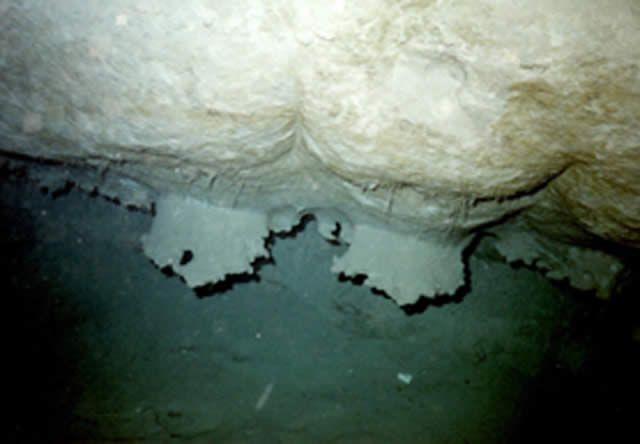Hévíz

The Hévíz Thermal Lake
The temperature of the spring lake of Hévíz is the result of the mixing of a cold and a hot spring gushing out from the depth of the Earth.
The temperature of the water is around 33-35ºC in the summer and 26-29 ºC in the winter. This temperature is neutral from the point of view of the temperature of the human body, so bathing in it is not exhausting but it refreshes and calms people with different diseases.
The lake „works” by a special mechanism. The mist that forms over the lake at night acts as a cushion, preventing the heat from gushing out with the water, so it provides a uniform temperature in the lake area.
How was the Lake of Hévíz formed?
The answer lies in the past, in the history of our Earth looking back to several million years. At the beginning of the Mesozic era, during the Triassic period (about 200 million years ago) crystal-clear sea water covered this region as well as the site of the present day Transdanubian Mountains. Out of this sea snow-white dolomite and limestone formed a deposit around Hévíz.
During the other two Mesozic periods, the Jurassic and the Cretaceous (about 180-170 million years ago) the sea withdrew from this area. In the territory of the present day Bakony Hills, at the end of the Cretaceous period and the during the first epoch of the Tertiary period, the Palaeocene bauxite deposits formed in a tropical environment, then redeposited due to surface impacts. These natural forces caused erosion in the softer layers of the ground surface, at some spots totally destroying them. Then started the karstification of limestone and dolomite.
During the Tertiary period even the Eocene, the Oligocene and the Miocene epochs following the Palaeocene did not leave layers behind, the region of Hévíz remained a 'mainland'. The last epoch of the period, the Pliocene, however, was very eventful.
At the end of the Pliocene and at the beginning of the Pleistocene (about 2 to 4 million years ago) the wind and water streams carried the majority of the material of the Pannonian layers southwards. The welling up of hot springs, and thus the Primordial Spring were the first sign of postvolcanic activities. Due to earth movements and the crustal collapse two trench systems were formed in the middle of the Pleistocene epoch. Moisture accumulated in them: Lake Balaton was formed about 22 thousand years ago. This was the time when the history of the Lake of Hévíz also started.
There are several pieces of evidence proving that the thermal water of the Lake of Hévíz did not well up at the level in the geological past it does today but much higher. The water of the Hévíz Lake welled up at its present site about 20-22 thousand years ago, simultaneously with the formation of Lake Balaton. The warm water rushing up first flowed into Lake Balaton. Due to the changes in the climate the water level of Lake Balaton dropped. A peat-moor formed from the once lush flora in the former basin of the lake.
The boggy, peaty, flat surface of the Hévíz valley extends 1-1.5 km eastwards of the lake as far as Mt. Dobogó at the eastern part of the valley and the mountain range of Cserszegtomaj surrounding the valley from the east. The peaty area extends southwards as far as river Zala and northwards as well as the country tavern of Gyöngyös.
The water of the Hévíz Lake is 'heated' by geothermal energy. The deep-seated waters enclosed in underground storage systems formed during the Triassic and the Pannonian periods are heated by heat conducted and radiated from deep-lying layers of the crust of the earth.
Based on the amount of carbon isotope in the water scientists have found out that the cold rill of the spring - from the period of penetration till the date of welling up - is 5-7 thousand years old, while the warm-water spring is 10-12 thousand years of age. Waters infiltrating into the depth from the surface come from a quite extensive area: from the Bakony Hills, the Keszthely Mountains and the Zala Hills. A part of the water does not permeate too deep into the ground (as far as the Pannonian layer) - this is the so-called karst water zone - and from here it gets into the 'mixing cave' of the Lake of Hévíz through the cold rill. The majority of the water gets much deeper, into the Triassic dolomite layers where it gets warmed up. During its journey it dissolves various metals and minerals, then it flows towards the surface again to arrive finally at the spring cave.
The discharge of the lake
Through the spring-crater 86 million liters of water breaks to the surface. The volume of the lake is about 100 000 m3 (about 100 million liters). The water of the whole lake is replaced in every two days. The spring carries about 2,64 million kJ of geothermal energy.
Apart from the springs of the lake, there are 7 artificial founts in the Hévíz area that have a total discharge of 2206 l/min. The water of these wells is used by various hotels and sanitariums to treat their patients.
The discovery of the spring crate and the cave
 Lake Hévíz had kept its secret for a long time because of its great depth.
Lake Hévíz had kept its secret for a long time because of its great depth.
Thef first arrived to explore it in 1908, but they only reached for 22 meters because of the extreme heat.
Later, in 1953 they reached the bottom but couldn’t enter the inside of the spring crater.
In 1972 two divers discovered a narrow gap at the bottom of the lake, 60-80 cms high and 2-3 ms wide, which turned out to be the entrance to the cave.
Finally, in 1975 István Plózer and his team entered this narrow gap where they had to fight against 39,5 ºC heat and a strong current of 30-40 thousands of liters of water. After this narrow gap they found a cave of 17 meters of diameter. There they found the secret of Hévíz, two springs. On the eastern side they found a colder spring (26,3ºC), and on the western, a hot spring (41ºC). The amount of the hot water is 9 times bigger than the discharge of the cold spring, so when they mix, the resulting temperature will be 39,5 ºC.
What should we know about the cave?
 The Lake was formed in the Triassic period, along a tectonic fault line. The cave itself was formed later, in the Pannonian period, by the currents and the turbulence of the water.
The Lake was formed in the Triassic period, along a tectonic fault line. The cave itself was formed later, in the Pannonian period, by the currents and the turbulence of the water.
The entrance to the cave can be found at 34 meters of depth. It is regularly cleaned out by scientists to regulate the amount of water coming out, and of course to make possible for tourists to enter it.
The depth of the cave is 40 m, the width is 17 m and its altitude is 14 m.
The cave is popular among divers. It is a great adventure to dive and explore the lake. However, you need a special permission because visiting the cave is requires experience and it is dangerous.
If we keep a close watch on the surface of the Hévíz Lake, we can see that it does not stand still.
Source: www.heviz.hu
Written by Mimi


 Lake Hévíz had kept its secret for a long time because of its great depth.
Lake Hévíz had kept its secret for a long time because of its great depth.  The Lake was formed in the Triassic period, along a tectonic fault line. The cave itself was formed later, in the Pannonian period, by the currents and the turbulence of the water.
The Lake was formed in the Triassic period, along a tectonic fault line. The cave itself was formed later, in the Pannonian period, by the currents and the turbulence of the water.